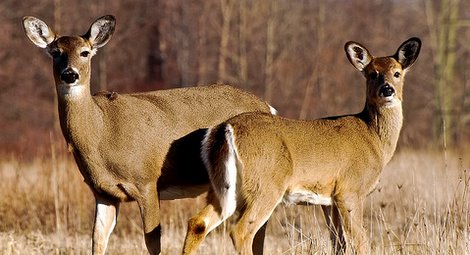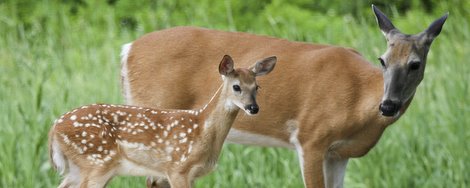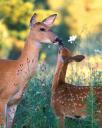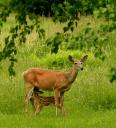
Last week I wrote an article discussing harvesting white-tailed deer early in the season, which I strongly recommend. The article discussed why it is important to remove deer before winter, especially does, and the benefits of having a deer herd at carrying capacity. Well, one reader posed a question that many of you may be interested in:
“What about nursing fawns early in the season? Will taking lactating does hinder growth and development in these young deer?”
Yes and no. To begin, whitetail fawns are usually weaned and become functioning ruminants at eight weeks of age. Most fawns at southern latitudes are born in late May and June, meaning the majority of fawns are weaned by the end of August. And this makes sense from a biological perspective, because as late-summer food sources deplete the doe can then rely on the fawn to nourish itself. This covers the majority of whitetail fawns that hunters will encounter in the field during the fall hunting season.

However, if you see a late-born fawn that still has spots, then I would not recommend harvesting the doe. Spots suggests that the deer is not old enough to survive on natural forage alone. With that said, fawn survival ultimately depends on habitat quality. Malnutrition and associated problems are the primary cause of poor fawn survival in most areas. Poor habitat does not help the doe feed the fawn, or the fawn feed itself after it is weaned. Poor habitat is bad for recruitment and drought conditions only aggravate the problem of inadequate food.
In general, harvesting does with fawns will not impact an individual fawn, unless of course the fawn is less than two months in age. Fawns older than two months, found in areas with good habitat, are just as likely to survive after the doe is removed. In short, if you need to remove does to get your deer herd at carrying capacity, do not hesitate to harvest does with older fawns.




Doe harvests (early vs. late), I believe an early kill is the best for two reasons: (1) reducing numbers on winter range, (2) you’re not killing does that your better bucks have serviced before they get harvested as trophys. However, there is a problem your readers must consider. By reducing the number of breedable doe in the herd early, the intensity of the rut goes way up (i.e. fights) not just in numbers of deer seen chasing, but in fatalities. Not to mention broken tines, main beams, and cripplings… as you know a permanently injured leg will deform a buck’s antlers for life. For years I’ve been looking for a solution to this major problem. Your thoughts would be appreciated.
Thanks-
Russell Taylor
STC Ranch
Brownwood,Texas
Bucks will always fight to some extent, regardless of the buck to doe ratio. Although some whitetail bucks break antlers and are hurt during these exchanges, the number of observed bucks with broken tines or hurt bucks does seem to increase as the number of bucks increases in proportion to the number of does.
In short, 1 buck per 6 does means less buck fighting than 1 buck to 1 doe. As resources (does) become restricted, competition (between bucks) naturally has to increase and bucks pay the price. Russell has a good point here, but unfortunately there is little a manager can do. Carrying too many does means less fights between bucks, but also makes it more difficult to control the deer population… and more mouths to feed. Less does means more fighting between bucks, but most deer managers understand that some bucks will, unfortunately, get busted up. The result is hunters trying to harvest bucks earlier in the rut or even pre-rut period. And this is ok if the deer manager is content with the remaining bucks (young and old) taking care of the available does. This is why it’s important to cull bucks at all age classes.
This year in Bandera County, we have suffered severe drouth conditions, thus the fawn crop has also suffered. Here on our ranch, we are still in the process of reducing the doe population and I was wondering, if when deciding which does to shoot, if the deer with fawns represent healthier and stronger deer given that they raised a fawn during this severe drouth?
I agree 100% with the author. We harvested what seemed like every doe on our propery to reach the quota… with the goal to do this before Thanksgiving. The reasoning…bucks will fight to get does…no matter the ratio…it’s just going to happen on your ranch or lease one way or another. Why kill does late that were bred by the good bucks or does that another buck may have died over? We actually experienced less broken antlers this year than EVER before in 10 years of intense management!!!
What difference does it make if you kill the doe before she is bred by your bucks? If you kill a doe, she ain’t getting bred. Just like folks talk about not killing does late because they have conceived fawns. Well, the same deer killed earlier in the season would still be the same dead deer.
I say shoot a doe when you get a chance to shoot a doe. If she has fawns they should be fine, and they should also stick around your farm or ranch until next year, without momma around to run them off.
I am 16. I just killed my first deer(doe), I was by myself. She had two fawns with her. I felt bad at first, but realized that they were old enough when they continued eating. The doe was 4 years old and 140 pounds. Not bad for my first deer.
I agree wit shooting does for proper management, but when is the best time to shot them, the early or late season?
Brian, the earlier you can remove them the better.
Killing the mother will not hurt the fawn’s chance of survival!? So it’s fine to shoot the mother in front of the babies! “Harvesting?” Do you ever think of these animals as the beautiful, complex sentient creatures God made them to be? And I know the explanation that if they are not hunted, there will be overpopulation and they will starve. But that’s because we have killed off their predators, and upset the ecological balance. Fine, if you hunt them, and you eat them, OK–But killing the mothers in front of the babies! Do you actually not care about the suffering you are causing? And it’s OK if they can feed themselves! Your cold-heartedness is unbelievable. Sickening.
Ashleigh, thanks for taking the time to share your thoughts on deer harvest. While we disagree, I respect your opinion. Genesis 9:3: “Every moving thing that lives shall be food for you. And as I gave you the green plants, I give you everything.”
Animals kill each other every day. Some over territory, some over breeding rights, but mostly just to eat one another. Unfortunately, all those deaths, as far as I can imagine, must be much more painful than a quick, ethical kill from a hunter. I don’t believe that animals share the same emotional connections that humans share with their families. If so, it would be one traumatic event after another, since momma deer have two fawns a year and I’ve never seen one walking around with ALL of her offspring. Many fawns are killed by predators, since they still exist.
Also, the hunting season for deer occurs in the fall, as after this point in the year the overwhelming majority of the young of the year (fawns) are weaned and able to forage on their own.
I agree with Ashleigh. The survival rate of fawns is lower than that of mature deer for starters, without its mother it drops further. With its mother a fawn is less prone to predation and is staying near it mother for a reason, for protection and learning. If the goal is to harvest meat while having the smallest impact on the population than shooting the fawn makes the most sense. However if the goal is to decrease the deer population, as it is in many areas, than it makes sense to shoot breeding age does especially when they have fawns. As hunters we need to be courageous and be aware of when our pride and ego allow us to justify actions that don’t match common sense.
Matthew, thanks for your take on doe harvest and population management. I think many folks approach deer management as it only works one way. In reality, proper management actions depend on the current situation and the desired overall goals.